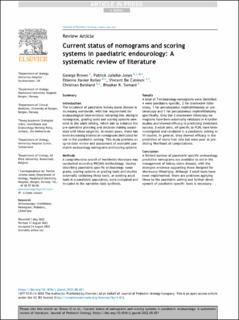| dc.contributor.author | Brown, George | |
| dc.contributor.author | Jones, Charles Patrick Warburton | |
| dc.contributor.author | Keller, Etienne Xavier | |
| dc.contributor.author | De Coninck, Vincent | |
| dc.contributor.author | Beisland, Christian | |
| dc.contributor.author | Somani, Bhaskar K. | |
| dc.date.accessioned | 2022-12-20T14:30:18Z | |
| dc.date.available | 2022-12-20T14:30:18Z | |
| dc.date.created | 2022-10-25T12:12:27Z | |
| dc.date.issued | 2022 | |
| dc.identifier.issn | 1477-5131 | |
| dc.identifier.uri | https://hdl.handle.net/11250/3038908 | |
| dc.description.abstract | Introduction
The incidence of paediatric kidney stone disease is increasing worldwide, with the requirement for endourological interventions mirroring this. Multiple nomograms, grading tools and scoring systems now exist in the adult setting, which aim to enhance the pre-operative planning and decision-making associated with these surgeries. In recent years, there has been increasing interest in nomograms dedicated for use in the paediatric setting. This study provides an up-to-date review and assessment of available paediatric endourology nomograms and scoring systems.
Methods
A comprehensive search of worldwide literature was conducted according PRISMA methodology. Studies describing paediatric-specific endourology nomograms, scoring systems or grading tools and studies externally validating these tools, or existing adult tools in a paediatric population, were evaluated and included in the narrative data synthesis.
Results
A total of 7 endourology nomograms were identified. 4 were paediatric-specific, 2 for shockwave lithotripsy, 1 for percutaneous nephrolithotomy or ureteroscopy and 1 for percutaneous nephrolithotomy specifically. Only the 2 shockwave lithotripsy nomograms have been externally validated in 4 further studies and showed efficacy in predicting treatment success. 3 adult tools, all specific to PCNL have been investigated and validated in a paediatric setting in 11 studies. In general, they showed efficacy in the prediction of stone free rate but were poor at predicting likelihood of complications.
Conclusion
A limited number of paediatric-specific endourology predictive nomograms are available to aid in the management of kidney stone disease, with the strongest evidence supporting those designed for shockwave lithotripsy. Although 3 adult tools have been implemented, there are problems applying these to the paediatric setting and further development of paediatric-specific tools is necessary. | en_US |
| dc.language.iso | eng | en_US |
| dc.publisher | Elsevier | en_US |
| dc.rights | Navngivelse 4.0 Internasjonal | * |
| dc.rights.uri | http://creativecommons.org/licenses/by/4.0/deed.no | * |
| dc.title | Current status of nomograms and scoring systems in paediatric endourology: A systematic review of literature | en_US |
| dc.type | Journal article | en_US |
| dc.type | Peer reviewed | en_US |
| dc.description.version | publishedVersion | en_US |
| dc.rights.holder | Copyright 2022 The Author(s) | en_US |
| cristin.ispublished | true | |
| cristin.fulltext | original | |
| cristin.qualitycode | 1 | |
| dc.identifier.doi | 10.1016/j.jpurol.2022.08.021 | |
| dc.identifier.cristin | 2064810 | |
| dc.source.journal | Journal of Pediatric Urology | en_US |
| dc.source.pagenumber | 572-584 | en_US |
| dc.identifier.citation | Journal of Pediatric Urology. 2022, 18 (5), 572-584. | en_US |
| dc.source.volume | 18 | en_US |
| dc.source.issue | 5 | en_US |

